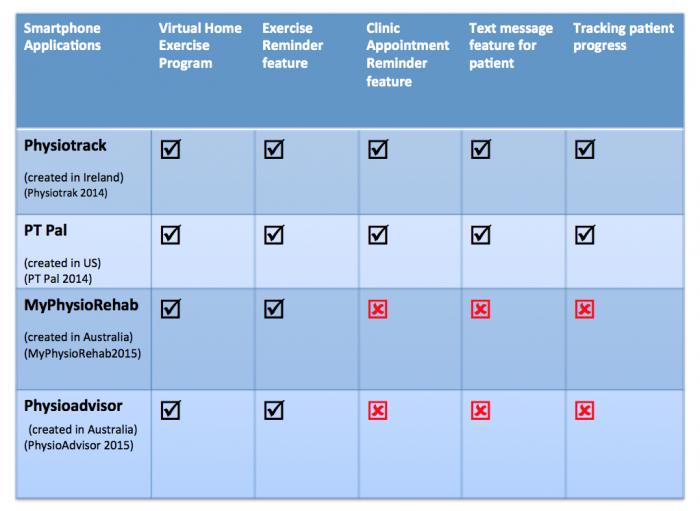Telerehabilitation and Smartphone Apps in Physiotherapy
Original Editor - Oriana Catenazzi, Alicia Rebellato, Hannah Meredith, Aaron Kirk, Martin Fitheridge, Marco Zavagni
Introduction to Telerehabilitation and smartphone physiotherapy applications
[edit | edit source]
add text here relating to introduction
Learning Outcomes
[edit | edit source]
add text here relating to the learning outcomes
Table of Contents [edit | edit source]
add text here relating to the table of contents
Overview of Telerehabilitation[edit | edit source]
add text here relating to diagnostic tests for the condition
Telerehabilitation[edit | edit source]
Progression of technology[edit | edit source]
Applications for specific conditions[edit | edit source]
Scotlands Telehealth and Telecare delivery plan[edit | edit source]
The patient perspective on telerehabilitation[edit | edit source]
Key points[edit | edit source]
Understanding the patient[edit | edit source]
Introduction[edit | edit source]
Over the last decade the development and use of telehealth interventions for changing patient behaviours has greatly increased (Riley et al.2011). The use of mobile applications must take in account the physical and socio-psychological needs of health practitioners and patients. The user approaching a device, is not purely interested in what the device does, but rather how the device makes them feel: the developer must remember that the application is developed focusing on the customer and is designed to satisfy all their needs (Ruiz et al., 2012). The ability to access extensive and multifaceted programs provides health care professionals with the opportunity deliver behavioural change interventions that can be adapted to meet the patient’s characteristics, behaviours and environment (Patrick et al. 2008). In order to analyse the effectiveness of these interventions, health behaviour theories and models are used to guide the development and delivery of the intervention (Riley et al. 2011). Bandura’s Transtheoretical Model (bandura, 1982) and Self-Determination Theory (Prochaska and Velicer, 1999) have served as the basis for many health care interventions and it is important that the physiotherapist understands the underlying principles behind these theories. The use of health behaviour models and theories will assist the health care professional at the initiation stage of the intervention to meet their baseline characteristics of the patient and also during the intervention when behaviour change is taking place. To understand our patient fully it is necessary to examine their motivation, efficacy, and goals, then apply a theoretical model to our intervention.
Transtheoretical model[edit | edit source]
Self-efficacy theory[edit | edit source]
Motivation[edit | edit source]
Self-determination theory[edit | edit source]
Goal setting[edit | edit source]
Clinical implications[edit | edit source]
Research[edit | edit source]
Current smartphone applications and modernization of physiotherapy
[edit | edit source]
Introduction
[edit | edit source]
Current physiotherapy applications[edit | edit source]
Further considerations: Improved communication [edit | edit source]
Facilitating patient-provider relationship[edit | edit source]
Utilising reminder services to enhance communication[edit | edit source]
Facilitating Knowledge and Education through Physiotherapist communication[edit | edit source]
Communicating the right exercise prescription[edit | edit source]
Further considerations: Facilitating behaviour change[edit | edit source]
Intrinsic and extrinsic motivation towards rehabilitation[edit | edit source]
Self-efficacy and goal setting[edit | edit source]
Cost effectiveness[edit | edit source]
Limitations
[edit | edit source]
add text here relating to the limitations
Conclusing Remarks [edit | edit source]
add text here relating to key evidence with regards to any of the above headings
CPD Test your knowledge [edit | edit source]
add appropriate resources here
References[edit | edit source]
References will automatically be added here, see adding references tutorial.







